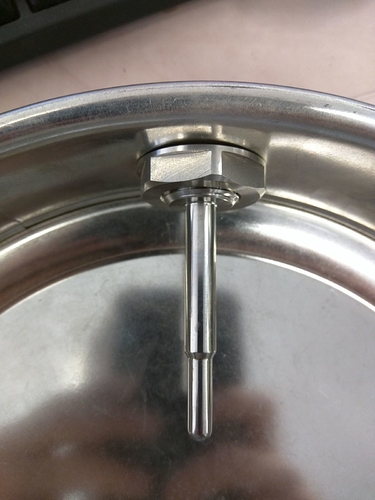Hello. This is my first post here. I am interested in BrewPi and I have started gathering parts. I live in Korea, so the heat of the summer makes it difficult to homebrew without some sort of temperature control, but I don’t want to leave the a/c on all day just to keep the beer cool. No problem in winter though. If you stay indoors.
Anyway, I had an idea about thermowells for the beer temperature sensor. I have searched but I have not seen a similar suggestion, so either it’s very innovative and cool, or it’s really dumb. I’d like a few opinions either way before I continue.
Basically, the common “waterproof” DS18B20 sensors we find on ebay, Amazon, or other sites such as this:
…are housed in a sealed stainless steel tube. The sensor is its own thermowell.
I have found that on the one that I have the heatshrink tube covering the joint between the stainless steel tube and the cable is not a tight fit and it would slide off, but that’s not a problem as I don’t intend to immerse the whole thing.
So, here’s the idea. The sensor is housed in a 50mm long 6mm diameter stainless tube with a sealed end. I am thinking of cutting a 30mm piece of silicone tube with 6mm internal diameter (ID) and 8mm or more outside diameter (OD). I would slide the silicone tube over the stainless tube at the heatshrink end, leaving 20mm of stainless tube protruding. Next, I’d drill a hole in my plastic brewing vessel slightly smaller than the OD of the silicone tube about half-way up the side. Finally, I’d push the sensor into the hole, maybe protruding about 30mm into the vessel (20mm stainless and 10mm silicone). The silicone material and stainless tube should be safe in the beer, and the silicone would be slightly compressed in the hole to make a good seal.
I have immersed the sensor in water for two weeks to see that it didn’t corrode (it didn’t), and a thermowell is made from stainless steel in the same way as the housing of this sensor, so putting one of these sensors inside a thermowell seems redundant.
Has anyone else tried this? Thoughts, opinions, and empirical evidence welcome.
Thank you.
 Is it really that bad an idea? Not really gone on the thermowells for 2 reasons, laziness and being awkward.
Is it really that bad an idea? Not really gone on the thermowells for 2 reasons, laziness and being awkward.
